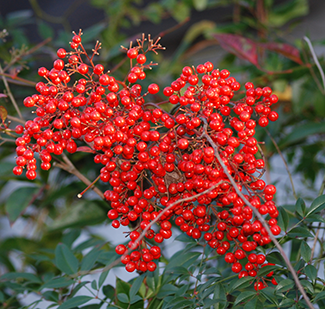
By Terry W. Johnson
Nandina's history in North America spans more than two centuries. This popular ornamental plant reached our shores in 1804. William Kerr was the first of many European plant hunters who scoured the Orient searching for plants that could be exported to the U.S. and Europe to serve as ornamentals. One of the many plants he deemed suitable for the nursery trade was nandina, which he subsequently shipped to the West. Ever since, nandina (also called heavenly or Chinese bamboo) has proved a popular ornamental throughout the Southeast.
At first glance, nandina seems ideal. It requires little care, is hardy and grows in wet and dry soils. To top it all off, the plant's beautiful dark green foliage and bright red berries persist throughout winter, adding a touch of color to an otherwise dull landscape. The showy berries and leaves also can accent the holiday spirit of a home landscape: Both are often used for wreaths and other decorations.
For decades, wildlife and garden experts touted nandina as a great wildlife food plant. One of the seeming virtues was that its berries hung on into winter, providing much-needed food for fruit- and berry-eating birds at a time when food is scarce.
However, in the 1960s, the plant's stellar patina began to crack as reports surfaced around the country that nandina was escaping from backyards and invading wild lands. The news first came from North Carolina, noting that nandina had naturalized and was threatening the Tar Heel State's native woodland plants. It wasn't long before similar problems surfaced throughout the Southeast.
Nandina was crowding out native plants, many of which were depended on by honeybees and native pollinators for pollen and nectar. The pervasive spread of nandina was decreasing biodiversity. The U.S. Department of Agriculture soon added heavenly bamboo to its infamous noxious weed list, alongside the likes of kudzu, Johnson grass and other destructive introduced plants.
The final crushing blow to the nandina's reputation was struck in 2009 when we learned that nandina berries are poisonous to birds. In fact, the berries are also poisonous to cats, dogs and other animals. At the forefront of the investigations that alerted the public to nandina's dark side were scientists at the University of Georgia's Southeastern Cooperative Wildlife Disease Lab in Athens.
In several instances of large numbers of birds being found dead in sites across Georgia, necropsies revealed that the birds' crops were packed with nandina berries. One such event took place in Thomas County, where dozens of cedar wings were found dead. The unfortunate birds had suffered from hemorrhaging in their heart, lungs and elsewhere. All apparently died from a deadly dose of hydrogen cyanide, a chemical produced by cyanide and other alkaloids found in nandina berries.
Wildlife experts say birds that ingest nandina berries can succumb to the poisoning in anywhere from a few minutes to an hour.
The reaction to the findings was swift. Once highly regarded for landscaping and as a wildlife food plant, nandina is now considered a pariah by a growing list of state, federal and private conservation agencies and organizations. Efforts to reduce the threat posed by nandina to wildlife and the environment have prompted attempts to control the spread of the plant on private lands. In addition, I am sure that the next generation of books on landscaping for wildlife will delete nandina from their lists of valuable wildlife food plants.
Yet, in spite of these efforts, nandina is still readily available at nurseries.
Each one of us can help by telling our neighbors of the threat posed by nandina. Additionally, if we are interested in wildlife, we should remove nandina from our yards. If you can't bring yourself to do so, at the very least, cut off and dispose of the clusters of nandina berries that appear on your plants before the birds find them.
You can also replace your existing nandina with one of the newly developed sterile varieties. However, since these plants will spread by sending out rhizomes – like the popular plant currently growing in our yards – please confine these sterile plants to containers. Better yet, plant a native plant such as yaupon holly in its place. This native plant retains its green leaves and red berries throughout the winter, too.
I am sure William Kerr never dreamed that a plant he exported to our young nation with the goal of enhancing home landscapes would end up causing more harm than good. I know that I, for one, never thought that nandina would ever fall from grace.
Terry W. Johnson is a retired Nongame program manager with the Wildlife Resources Division and executive director of The Environmental Resources Network, or TERN, friends group of the division’s Nongame Conservation Section. (Permission is required to reprint this column.) Learn more about TERN, see previous “Out My Backdoor” columns, read Terry’s Backyard Wildlife Connection blog and check out his latest book, “A Journey of Discovery: Monroe County Outdoors.”



















